Weapons built in ancient and medieval days were ruthless, sturdy, and brutal. However, they were made with ease and perfection.
A great critical skill, proper analytics, and creativity were included to create even the tiniest piece of the war weapon. The weapons were made with a great deal of planning to get the victory during the battle.
Every empire or civilization had a unique design and shape for their weapon. For instance, a class of Roman Gladiators named Scissors had a custom-designed weapon for them and was named Roman Scissors.
Every leader and the empire were in search of the perfect weapon. Some came up with a large one while the other with a tiny one.
The strength could not be judged from its size, for instance the tiniest one Shuriken proved to be the deadliest weapon invented
Special weapons were made for special occasion, some were made to protect and some to assassinate
Here is the list of top 10 most popular ancient weapons with their details.
10. Shuriken
Content

Source: Wikimedia Common
| Originated in | Japan |
| Date of origination | 1596 |
| Dimensions | 12 to 15 cm, weighing from 35 to 150 grams |
Shuriken, a dangerous weapon, originating from Japan during the 1956, was small in size. It was used as a hidden dagger and was also known as ninja stars or throwing stars.
It was shaped as a star, round in the middle with sharp and pointed edges. The edges were made sharp and pointed to products cut on the opponent’s body.
In some cases, the edges were also soaked in poison and in animal’s feces to pass on the bacterial infection into the body of the opponent through the cuts.
The skills to practice this tiny weapon was taught as one of the martial arts and was used during the times of the ninja for over 100 years. Besides ninja, it was also used by the Samurai and Asiguru soldiers.
9. Khopesh

Source: Wikimedia Common
| Originated in | Ancient Egypt |
| Date of origination | During Bronze Age around c. 1500 BC |
| Dimensions | 50 to 60 cm |
Khopesh, commonly known as sickle-sword, originated in Ancient Egypt. It measured around 50 to 60 cm and the weight depended on the metal used in it.
It was the modified form of battle axes, usually made from the single piece of bronze and was pretty heavy.
The weapon was actually the symbol of the gods and specially the symbol of the power of the Pharaoh. He is depicted holding the Khopesh in most of the ancient arts and in some the devotees are seen offering him the Khopesh.
The shape of this weapon had a sickle shape whose inner portion was used to disarm any enemy by hooking their weapon and the arm with the curved blade.
While the outer Outer edge sharp around the curved portion and they were used to attack or harm the opponent.
8. Urumi
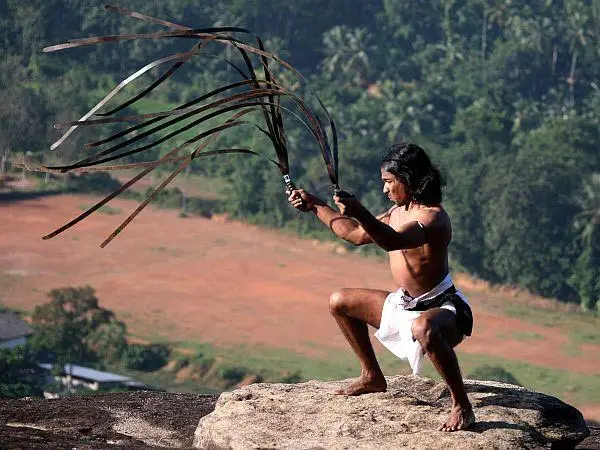
Source: Wikimedia Common
| Originated in | Tamilakam, modern-day Kerala |
| Date of origination | around the 6th Century BCE |
| Dimensions | 150 to 160 cm |
Urumi, also known as Chuttuval was used in Tamilakam, since the 6th Century BCE.
The weapon was a part of Kalaripayattu martial arts, an Indian style of fight, which is one of the oldest forms of the fight. It was mostly used in one to one battles.
It was made by mixing multiple blades tied on one handle. The blades were mixed in a flexible manner with sharp edges that would cut anyone or anything in just a little touch.
Urumi is one of the most dangerous weapons which requires a special skill to practice. Only a highly trained person could use it as it could harm the swordsman himself if not handled in a correct form.
7. Double Bladed Haladie

Source: Wikimedia Common
| Originated in | India and Syria |
| Date of origination | around 18th to 19th Century |
| Dimensions | about 22 cm |
Double Bladed Haladie, originated in India and Syria, was mostly used by the Rajput. It was invented between the 18th to the 19th Centuries and measured about 22 cm.
The weapon had two double-edged blades that were connected to the ends of a single handle placed in the middle.
Some Haladies were made in different shapes where they were attached to a metal band that looked similar to a knuckle duster covering one of the sides of the handle.
The knuckleduster would have another blade attached to it and was used for dual purpose, slicing, and stabbing.
The Haladie was mostly used in combat and also in ceremonies as Rajput’s culture and ritual.
6. Roman Scissor
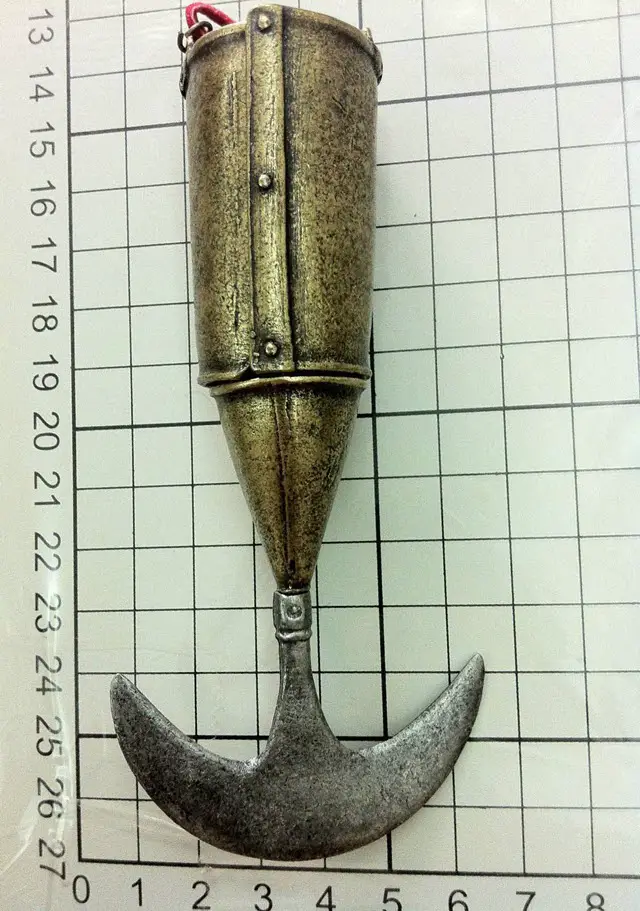
| Originated in | Ancient Rome |
| Date of origination | around 100 AD |
| Dimensions | about 45 cm |
Roman Scissors, invented around 100 AD in Ancient Rome, was mainly by the Roman Gladiators during their battles.
It was named as Roman scissors as it was used by the gladiator belonging to the Scissors class. The Scissors used this weapon to fight against the Retiarius. Retiarius would arm themselves with a net and a slaughter.
Roman Scissors were made in a unique shape with a tube shape in one end vehicle the other end had a cylindrical shaped pipe and a sharp blade attached as a crescent.
The gladiators put their arm in the long tube as it would work as a handle and a protector of the arm. The tube was also used to block the opponent’s attack while the sharp edge was used to attach the opponent.
5. Katar
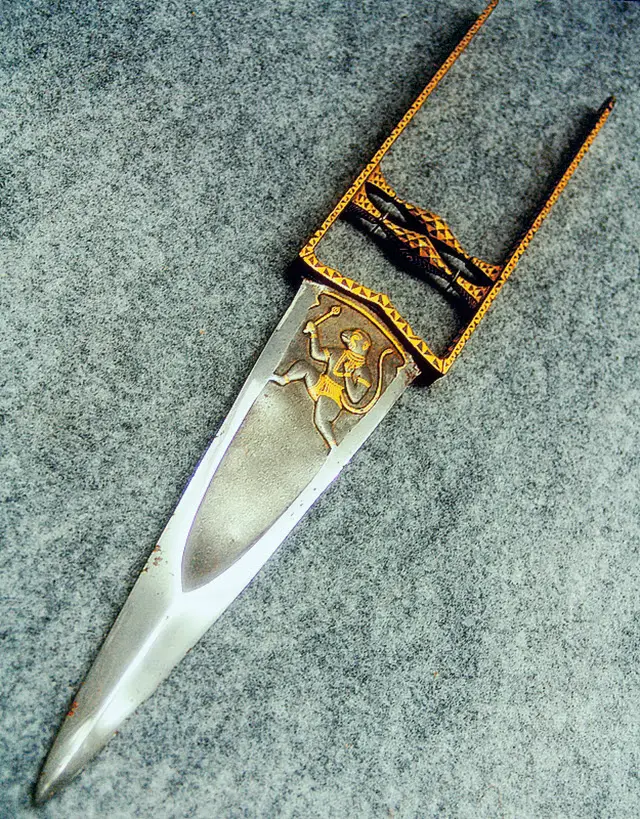
Source: Wikimedia Common
| Originated in | Vijayanagar Empire, Southern India |
| Date of origination | 14th Century |
| Dimensions | 30 to 90 cm |
Katar originated in Southern India, was commonly known as the Bundi dagger or a push dagger. It was one of the most dangerous weapons as it was used as the single-shot assassination tool.
The weapon was the most used weapon in the Indian martial arts. It was mostly used by the Tamil infantry units known as Kaalatpadai.
It was shaped like a sharp knife with an H-shaped handle. The handle was held using the middle and index finger. However, the blades were of different shapes, some straight and some curved.
The edge was very sharp and was mostly used to stab the opponent. It could also break the shield walls of the enemies and armors.
People also used it to worship during various ceremonies and rituals as they considered this weapon as a sacred weapon.
4. Shotel
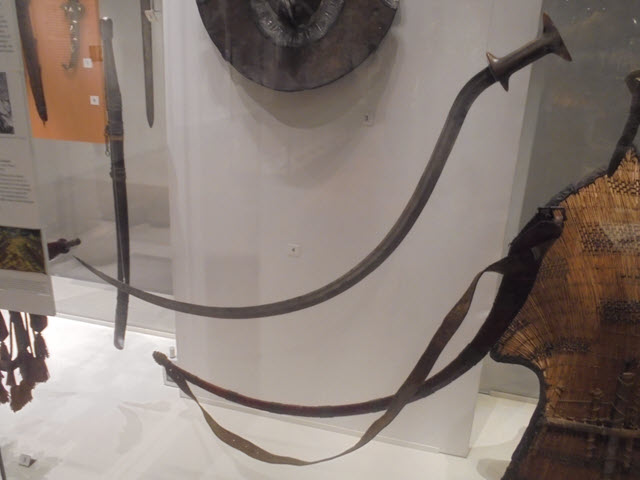
Source: Wikimedia Common
| Originated in | Ancient Ethiopia |
| Date of origination | around 980 BC |
| Dimensions | around 101 cm |
Shotel commonly known as sickle – sword originated in Ancient Ethiopia around 980 BC. It measured around 101 cm.
It was one of the most popular weapons as it looked vicious and also would puncture opponents with a little touch. Its shape was made in such a way that others could hardly block it with another sword or a shield.
Mounted and unmounted soldiers used it as they could easily attack the body organs like the kidney and lungs of their opponent with sharp and curved blades.
However, it was very difficult to use due to its length and shape. Also, it would take some time just to take the sword out from its Scabbards and could harm the swordsman during the process.
3. Wave-bladed sword

Source: Wikimedia Common
| Originated in | Germany |
| Date of origination | around 15th Century |
| Dimensions | about 41 cm |
Wave-bladed Sword, originated in Germany, was commonly known as flame-bladed sword or Flamberge. It measured around 41 cm and was heavy enough to need two hands to hold it.
The name Flame-Bladed came up due to its unique character of producing flames and vibrations while combating with the opponent.
The thin, long, and very sharp blades would help in attacking and hurting the opponent along with producing the vibrations by the waves of the blades. These blades were used mostly by well-trained and experienced swordsmen
There were different types of Wave-blade sword made during that period. One of the famous one was the two-handed flame-blade sword which was known as Flammernschwert.
This weapon was one of the most dominant weapons during the Renaissance as it caused numerous deaths and saved the swordsmen from their opponent.
2. Maduvu
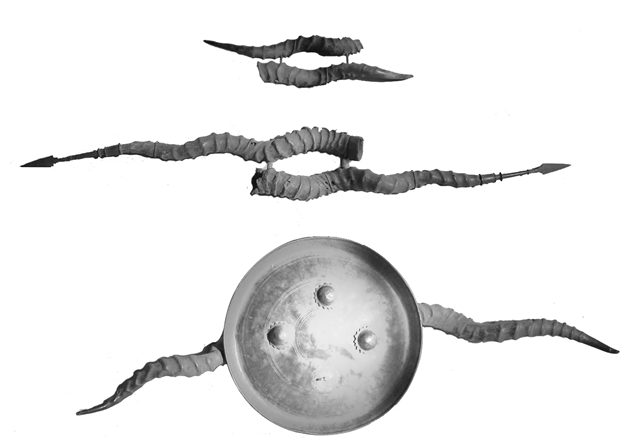
Source: Wikimedia Common
| Originated in | Ancient India |
| Dimensions | about 158 cm |
Maduvu, originated in Ancient India, was commonly known as Maru, Maduvu, and Fakir’s horns.
This unique piece was designed as the Fakirs, Hindus and Muslims ascetics and mendicarts were not allowed to carry weapons.
It was actually made from two antelope horns and connected by a crossbar. The two horns pointed in opposite directions which were excellent for stabbing and attacking the opponent.
However, along with time the weapon got modified and was made using steel. It was also used as a defensive weapon.
The practice of this specially designed weapon is still there as one of the martial arts of India, known as Silambam. They now use the deer horns and it is named Maan Kombu.
1. Bagh Nakh
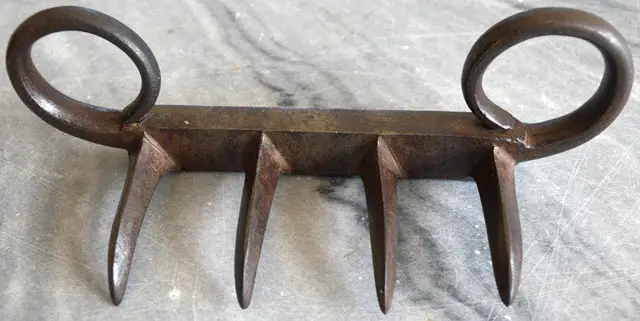
Source: Wikimedia Common
| Originated in | India |
| Date of origination | around 18th to 19th Century |
| Dimensions | about 51 cm |
Bagh Nakh, a famous weapon that originated in India, is also known as Vagh Nakh meaning Tiger’s claw.
It is shaped as a claw which consists of four to five curved blades . The blades are fixed with a glove or a crossbar for the fingers to hold on to it.
Crossbar has two holes made to support the thumb and the pinky finger and rest part would support against the palm.
The sharp blades are made to slash the opponent’s skin or the muscles. So, it is incredibly dangerous which was mounted on the knuckles
According to the legend, the claws had the poison withdrawn from a poisoned tiger and used by the Rajputs for the assasination in their beginning days.
It was first used by the emperor Shivaji in order to defeat Afzal Khan, a Moghul general, and the ruler of Bijapur.
Conclusion:
Every weapon mentioned proved to be unique and dangerous with its own speciality. Most of them were made from the same material but in different shapes and sizes.
These weapons made a huge impact during the battles and some still until present day. However, they have shown rapid changes in the production, metalworking, and are based on the needs of the soldiers.
Other weapons besides the ones mentioned above includeFlaming Arrow, Katana, and Kakute.

I’m sorry this is harsh, you need to be brought up short. You know almost nothing about historical weapons. The Shuriken, tigers claw, whip sword, Katar, Gladiators scissor ALL have Pathetic range are useless against even textile armor. Think about that, these things are only effective against unarmored, poorly armed individuals, because not a single listed weapon is suitable to use in a formation. Here is a rough but actual list of some of the most effective weapons from the last 2000 years.
1. The Spear, it’s the undisputed king of the pre-firearm pantheon. It’s fast along it’s long axis, provides unmatched range, can defeat gaps in most armor, is ideal en masse, and it’s cheap, fast, and easy to create.
2. Pole arms, like the halberd, guisarme, Bill Hook, bardiche, lochaber axe are second only to the king. They possess most if not all the properties of a spear, and are intended to minimize the advantage a mounted warrior has. Unlike the spear though, many polearms can deliver devastating cuts and chops.
3. The Polaxe or Pollaxe
It serves the anti-armor role of artillery or man portable missile. With a wicked spike on the head and on the butt end, a hammer, axe blade, steel reinforced shaft and extra heft, it’s purpose is simple: kill a man inside a steel cage. Because it packs the extra mass to punch through or crush carbon steel plates, it is a poorer choice against light troops like archers or skirmishes.
4. The war bow, and crossbow.
While their overall damage potential and range is somewhat similar their military use is a bit different. The war bow took 10 to 12 years to achieve proficiency, where the crossbow takes hours. However, the war bow has a much much higher rate of fire, range, and launches a much heavier arrow than the bolt of even large crossbow.
5. The 1-handed axe, War pick and warhammer. With the option of a spike/blade or Spike/hammer face, this is the most effective category of anti-armor single hand weapon. Retaining effectiveness against all armor types at the cost of some speed make these very capable, and allow the wielder to deal with most any opponent. (the bec-de-corbin and Lucerne hammer, belong to the polearm-polaxe crossover)
6.The Mace, bludgeon, war club, flail: while closely related to the last group, these are less effective against harder armor because they don’t focus force on a small surface. (With the notable exception of the flanged mace).
7. The arming sword. This was the pistol of its day. Single hand grip, wide blade, large quillions, with a pronounced distal taper. The arming sword was a fallback, never a primary weapon. It could be supported by the offhand halfway up the blade, and could slip through and in some cases penetrate thinner plates, but that would be a desperate situation.
That should give you an outline and the reasons I’ve rated each weapon above or below others.
For other sources, check out Skallagrim’s, and Schologladitoria’s YouTube channels.